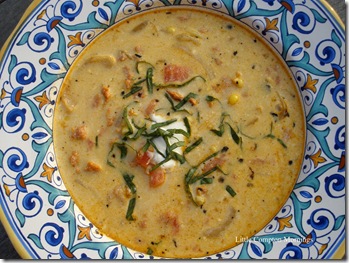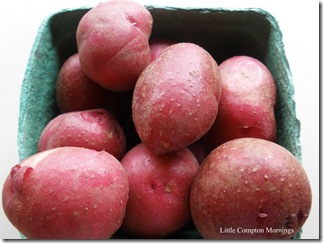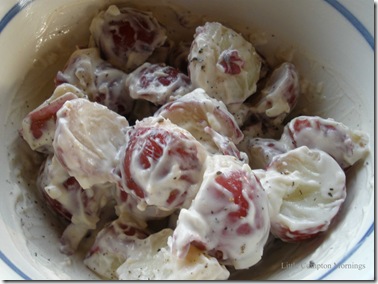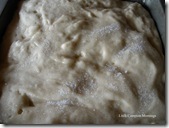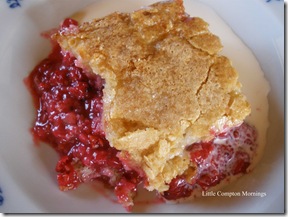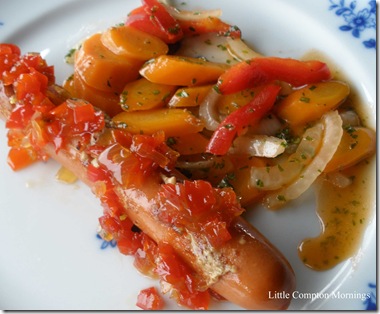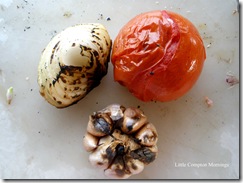 While glorious, this run of spectacular July weather we’ve been having has brought its share of still, humid evenings. For the most part, there’s been a lovely breeze, but the other night was one of those times when the thought of boiling water for the corn—one of my favorite varieties, Temptation—made me wilt. Or turning on the stove generally. I love hot weather, cannot abide air conditioning, and begin to complain of the cold when the temperature drops below about 65, so if it is too hot for me, it is hot.
While glorious, this run of spectacular July weather we’ve been having has brought its share of still, humid evenings. For the most part, there’s been a lovely breeze, but the other night was one of those times when the thought of boiling water for the corn—one of my favorite varieties, Temptation—made me wilt. Or turning on the stove generally. I love hot weather, cannot abide air conditioning, and begin to complain of the cold when the temperature drops below about 65, so if it is too hot for me, it is hot.I’d been planning to make some corn chowder, and was about to give up the idea as too steamy when I thought, why not just grill it? Everything over a single outdoor fire, sort of like camping, but with sleeping inside. This seemed like a reasonable thing to do. After all, here in Rhode Island, and popular elsewhere, we grill pizzas, made famous by Al Forno restaurant. Yes, you’re thinking, but pizza is solid, and chowder is, let’s face it, liquid.
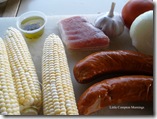
Ah, but the liquid is the final stage—sort of the reverse of grilled pizza, where the grilling is the final stage after preparing dough, sauce, and so on. For a grilled chowder, it seemed logical to grill all the ingredients and then add the liquids to them, in a pot set on the by-then moderate-heat grill. The depth of flavor, and the no muss, no fuss, of charcoal grilling--for a soup.
So I did that, and it turned out very well; I’ll do it again. I don’t take any particular credit, beyond the original desperate thought of how to avoid the stove: with fresh-picked corn and tomatoes, locally grown or produced chouriço, corn, garlic, and basil, and your own corn stock from inventory, you can’t really go wrong. Or as we say around here, what could be bad? As it turns out, absolutely nothing.
LCM Grilled Corn and Chouriço Chowder
Except for the basil garnish, this is cooked entirely on the grill. It makes for a summery but satisfying meal; nothing more is needed but a green salad or some buttered (and grilled, of course) common crackers. Serves 4.

¼ lb lean salt pork, rind removed
½ lb (1 link) chicken chouriço, such as Sardinha’s
4 large ears of corn, shucked
½ large sweet onion, cut in two
2 large cloves garlic, from a head (see directions)
1 medium-large ripe tomato
2 ½ cups corn stock (see Note)

1 cup whole milk
¼ cup sour cream, plus more for garnish
¼ tea salt
4 twists of the pepper mill
Olive oil
About 8 large basil leaves
Prepare a medium-hot fire on the grill. Cut a square of aluminum foil large enough to hold the tomato, a head of garlic, and the onion. Brush the corn, garlic, onion, tomato, and meaty side of the salt pork lightly with the olive oil.
Put everything on the grill, placing the pork meat-side down. Quickly cook the vegetables, allowing them to char slightly but not to burn, turning them over to brown. Turn the chouriço once. After about 5 minutes, remove the corn, the salt pork, and the chouriço and set aside, and move the onion, garlic, and tomato to the square of foil. Put the lid on the grill to continue cooking until the vegetables can be pierced with a knife but still hold their shapes—i.e., the tomato should not collapse, the garlic should not ooze.
 Cut the corn off the cobs, and slice the chouriço, breaking the slices apart with your fingers and discarding the skin that wants to come off. Slice the onion, and thinly slice 2 fat cloves of roasted garlic, reserving the rest for another use. Remove the skin and stem end from the tomato; cut it in half and gently fish out the seeds with a finger; and chop the tomato flesh roughly. Cut the salt pork into small dice.
Cut the corn off the cobs, and slice the chouriço, breaking the slices apart with your fingers and discarding the skin that wants to come off. Slice the onion, and thinly slice 2 fat cloves of roasted garlic, reserving the rest for another use. Remove the skin and stem end from the tomato; cut it in half and gently fish out the seeds with a finger; and chop the tomato flesh roughly. Cut the salt pork into small dice.Place a 3-qt chef’s or other open pan on the grill; use your flat palm to find a spot where the heat is medium to medium-low (alternatively, use your stove for this last stage, no more than a few minutes). Quickly toss the salt pork, chouriço, onion, and garlic in the pan, adding a teaspoon or so of olive oil if needed to prevent sticking. Add the stock, the corn, and the tomato, and season with the salt and pepper; move the pan to the coolest spot (or reduce the heat to low), and stir in the milk and the sour cream. As soon as the soup is hot through, remove it from the heat, taste it, and adjust the seasoning if necessary. Garnish with sour cream and finely cut basil.
______
Note: As discussed in a post from last year (click the corn stock link above), I try to always have corn stock on hand; it's versatile and flavorful, and it is not much effort to throw a few cobs into water to make it. If you do not have it handy, though, you could use a very light, minimally salted chicken stock.
